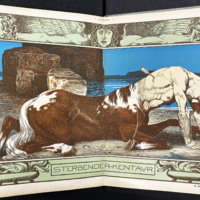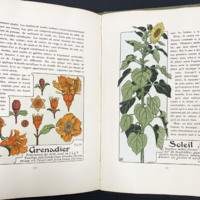Art Nouveau and the Vienna Secession
Click each image to view additional photos
Beginning in the 1890s, artists, designers, decorators, and architects launched a major stylistic movement rooted heavily in nature and with the goal of a holistic aesthetic across the fine and applied arts. The movement would be known as Art Nouveau, as it initially developed in Brussels and then Paris, followed by the rest of Europe and Russia, where it would take on different names and national or regional traits. Major figures associated with the movement include Louis Comfort Tiffany, Henry Van de Velde, Alphonse Mucha, Hector Guimard, Joseph Sattler, and Victor Horta, and many others. After the movement’s popularity died out, some of its artists and designers were instrumental in the emergence of the modernist and avant-garde movements, particularly in Weimar, Germany, where the Staatliches Bauhaus first began operation.
In Great Britain, Aubrey Beardsley co-founded, along with Henry Harland, and served as initial art editor for the famous but short-lived Yellow Book, a quarterly literary magazine. “Yellow book” was a reference to the illicit French novels bound in yellow that were popular at the time, and the magazine embraced fin de siècle decadence and aestheticism. Numerous of Beardsley’s own iconic pen and ink illustrations, considered some of the earliest manifestations of Art Nouveau, are found throughout the issues published under his art editorship.
Henry Van de Velde is counted among the movement’s early founders as it emerged in Belgium, and upon relocating to Germany, among the major figures of the synonymous Jugendstil. Van de Velde’s exquisite edition of Nietzsche’s Also sprach Zarathustra embodies the German concept of gesamtkunstwerk (total work of art) and is one of the most beautiful, expensive art nouveau books ever printed. The movement’s Munich-based magazine, Jugend, printed art in the quintessential style but became increasingly nationalist in ideology, particularly as National Socialism rose to prominence.
Art Nouveau publications made heavy use of chromolithographic printing to achieve affordable yet rich color variations and aesthetic appeal. Books were printed to showcase the extensive options available for pochoir, wallpaper, textiles and other decorative arts. M.P. Verneuil’s Étude de la Plante features endless variations on plant forms in the elaborate and ornate style of Art Nouveau.In Vienna, Austria, a distinct offshoot of art nouveau took on a more feminine, less nationalist style. The Vienna Secession was founded in 1897 by a group of artists including Gustav Klimt, Koloman Moser, Josef Hoffmann and others. The movement’s official organ, the magazine Ver Sacrum, ran from 1898-1903 and features drawings, designs and literary contributions.




